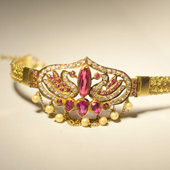Design Resource
Baajuband - Belgaum
Traditional Gold Jewelry
by
Prof. Bibhudutta Baral, Divyadarshan C. S., Lija M. G., Shruti K. and Smitha S.
Indian jewelry has a vast history, which dates back from 5000 years and has occupied a distinct place in India. Traditional and ethnic jewelry is very famous in India and an all-time favorite among people. The pattern made in Indian jewelry is extraordinary pattern and form is occasionally astonishing. The traditional and precious components of ornaments have significance position and status in society. Belgaum is an important district headquarters in the state of Karnataka, which has a very rich culture practiced, famous for handmade crafts, which are carried from a long generation. Kannada, as well as Marathi, has influenced the traditions of Belgaum. Most handmade crafts of Belgaum are based on weaving and jewelry making which signifies many occasions and also part of gifts.
Baajuband is one of the traditional gold jewelry made in Belgaum. It’s a kind of design that only made in Belgaum and followed from tradition. According to the artisan in Belgaum, Baajuband making was started in the year 1940 which is practiced till today. However, wearing Baajuband is in practice since many centuries from the king’s time. Baajuband or an armlet is an ornament, which decorates the upper part of the arms. It reflects the royal style and richness. Women and men wore the traditional ornament as well, but at present women mostly wear it on the wedding day or any other auspicious occasions, on traditional sarees and sleeved attires. Baajuband has transformed many terms and designs but the concept of making these ornaments remains the same. This ornament is made with both gold and silver.








